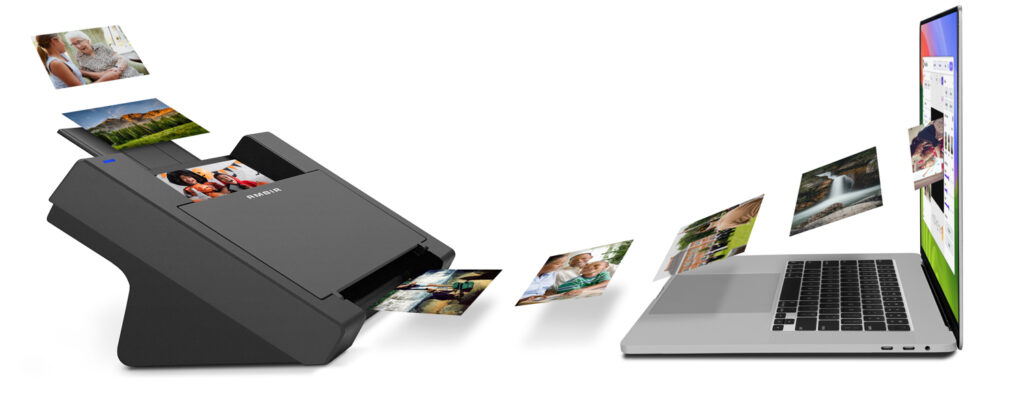What is a photo scanner? A photo scanner is a device used to digitize physical photographs, converting them into digital images. This allows you to store, edit, share, and preserve old photos more easily. Photo scanners typically use high-resolution scanning technology to capture fine details and colors, ensuring that the digital version closely resembles the original photograph.
Most scanners are stand alone hardware that produce a digital file as an output. This digital file can then be imported into other applications or social media for sharing. New solutions like AMBIR’s PictureStudio combine traditional photo scanner hardware with cutting edge photo editing/sharing software.
There are several different types of photo scanners:
Flatbed Scanners: Sheetfed scanners look like traditional scanners home document scanners in that you lay an image flat face down like you would do with a photocopy machine.
Sheet-fed Scanners: These scanners pull the photo through the machine, scanning as it moves. Sheet-fed scanners tend to be faster than flat bed scanners.
Handheld Scanners: These are portable devices that you manually move over the photo to scan it. They are less common but can be useful for scanning on the go.
Dedicated Photo Scanners: These are specialized for photos and often include features like high-resolution scanning, color correction, and automatic dust and scratch removal.
Photo scanners are particularly useful for preserving old family photos, creating digital archives, and sharing memories with others, especially over social media.

Common Uses for a Photo Scanner
A photo scanner can be used in various ways to preserve, share, and enhance your photographs. Here are some ideas:
1. Digitizing Old Photos
- Preservation: Scan old family photos to create digital copies that can be stored safely and protected from physical damage, like fading or tearing.
- Archiving: Organize your digital photo collection by creating folders, tagging photos, and backing them up on cloud services or external drives.
2. Restoring Photos
- Editing and Enhancing: After scanning, use photo editing software to restore faded colors, remove scratches, and improve the overall quality of old photos.
- Reprinting: Once restored, you can print new copies of old photos at higher quality.
3. Creating Digital Albums
- Sharing with Family and Friends: Create digital albums that can be easily shared via email, social media, or cloud storage. This makes it easier to connect with relatives who may not have access to the physical copies.
- Online Albums: Upload scanned photos to online services like Google Photos, where you can create and share albums with specific people.
4. Making Gifts and Keepsakes
- Photo Books: Compile scanned photos into custom photo books for special occasions like birthdays, anniversaries, or family reunions.
- Calendars, Cards, and Prints: Use your digital photos to create personalized calendars, greeting cards, or framed prints.
5. Preserving Documents
- Scanning Important Documents: Besides photos, you can use the scanner to digitize important documents like birth certificates, marriage licenses, or letters, preserving them for future reference.
6. Creating Artistic Projects
- Collages and Scrapbooks: Digitize photos to use in digital or physical collages, scrapbooks, or other creative projects.
- Slideshows and Videos: Use the scanned photos to create multimedia presentations, like slideshows or video montages, for events or as keepsakes.
7. Genealogy Research
- Family History Projects: Scan and organize photos for genealogy research, creating a visual family tree or timeline that can be shared with other relatives.
- Documenting Ancestry: Combine scanned photos with family stories to create a digital record of your ancestry that can be passed down through generations.
Using a photo scanner opens up many possibilities for preserving and sharing memories, making it a versatile tool for both personal and creative projects.
How is a photo scanner different or better than using an mobile phone?
Mobile phone apps for editing, repairing or improving old physical photos are often reliant on the user taking a picture of a picture. Even if you are using a scanning app on the phone, you’re still making a copy of the original under less than perfect circumstances. Ambient light, shadows, phone quality will all further degrade the photo you are trying to digitize whereas a true image scanner provides a near perfect digital copy of the original photograph or film (by perfect we mean exact copy, not an inherent improvement on the original).
About AMBIR and Picture Studio
For over 25 years, AMBIR, a Chicago-based manufacturer, has been renowned for its high-quality business scanning and digital capture equipment. From document and ID scanners to insurance and business card scanners, AMBIR’s products are trusted across industries like healthcare and financial services.
Now, AMBIR brings its expertise directly to consumers with PictureStudio. Designed to revolutionize photo scanning, PictureStudio combines affordable, high-quality hardware with state-of-the-art AI software. Enhance, organize, and share your most precious memories effortlessly with PictureStudio by AMBIR.






